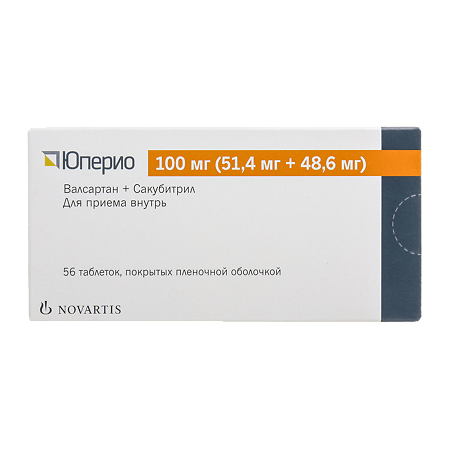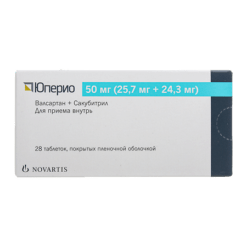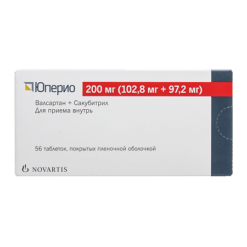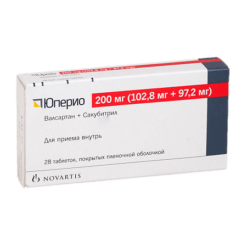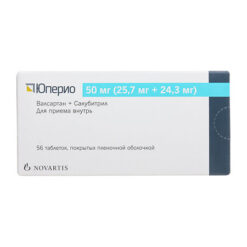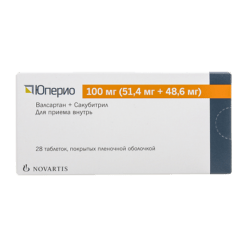No products in the cart.
Huperio, 100 mg 56 pcs.
€90.27 €78.24
Description
Pharmacotherapeutic group: not assigned.
The ATX code: C09DX04.
Pharmacological properties
Mechanism of action
The action of Huperio is mediated by a novel mechanism, namely the simultaneous inhibition of neprilysin activity (neutral endopeptidase (NEP)) by sacubitrilate (the active metabolite of sacubitril) and blockade of angiotensin II type 1 receptors (AT1) with valsartan, which is an angiotensin II receptor antagonist (ARA II).
Sacubitrilat increases neprilysin-degradable peptides (such as natriuretic peptides (NUPs)), which, while suppressing the negative effects of angiotensin II with valsartan, result in the complementary beneficial effects of sacubitril and valsartan on cardiovascular and renal health in patients with heart failure. NUPs activate membrane-bound guanylyl cyclase-conjugated receptors resulting in increased cyclic guanosine monophosphate (cGMP) concentration causing symptoms of vasodilation, increased natriuresis and diuresis, increased glomerular filtration rate and renal blood flow, suppression of renin and aldosterone release, decreased sympathetic activity, and antihypertrophic and antifibrotic effects.
Valsartan, by selectively blocking the AT1 receptor, suppresses the negative effects of angiotensin II on the cardiovascular system and the kidneys and also blocks angiotensin II-dependent aldosterone release. This prevents persistent activation of the renin-angiotensin-aldosterone system (RAAS), which causes vasoconstriction, renal sodium and water retention, activation of cell growth and proliferation, and subsequent maladaptive cardiovascular remodeling.
Pharmacodynamics
The pharmacodynamic effects of the sacubitril and valsartan complex of the drug were evaluated after its single and repeated use in healthy volunteers as well as in patients with chronic heart failure. The observed effects corresponded to the mechanism of action of the complex of active substances, consisting in simultaneous inhibition of neprilysin and RAAS blockade.
. In a 7-day study in patients with reduced left ventricular ejection fraction (LVEF), in which valsartan was used as a control, the use of sacubitril and valsartan complex resulted in a statistically significant short-term increase in natriuresis, increased urinary cGMP concentration and decreased plasma concentrations of mid-regional atrial natriuretic peptide precursor (MR-proANP) and N-terminal fragment of brain natriuretic peptide precursor (NT-proBNP) (compared with valsartan). In a 21-day study in patients with reduced left ventricular PV, use of sacubitril and valsartan caused statistically significant increases in urinary atrial natriuretic peptide (ANP) and cGMP and plasma cGMP concentrations, as well as decreases in plasma NT-proBNP, aldosterone and endothelin-1 concentrations (compared with baseline).
In addition, use of the sacubitril and valsartan complex blocks the AT1 receptor, as indicated by increased plasma renin activity and concentrations. In another study, the complex of sacubitril and valsartan caused a more pronounced decrease in plasma NT-proBNP concentrations and a greater increase in urinary concentrations of brain natriuretic peptide (BNP) and cGMP than did enalapril. While BNP is a substrate of neprilysin, NT-proBNP is not, so NT-proBNP, unlike BNP, can be used as a biomarker in monitoring patients with heart failure receiving sacubitril and valsartan complex.
In a study detailing the QTc interval in healthy male volunteers, the use of sacubitril and valsartan complex once at doses of 400 mg and 1200 mg had no effect on myocardial repolarization.
Neprilysin is one of several enzymes involved in amyloid-β (Aβ) metabolism of brain and cerebrospinal fluid (CSF). In healthy volunteers, the Aβ 1-38 concentrations in the CSF were increased with the use of sacubitril and valsartan at a dose of 400 mg once daily for 2 weeks, while the Aβ 1-40 and 1-42 concentrations in the CSF were unchanged. The clinical significance of this finding is unknown.
In a clinical trial, use of the sacubitril and valsartan complex in patients with chronic heart failure statistically significantly reduced the risk of death due to cardiovascular disease or hospitalization due to heart failure (21.8% in the study drug group versus 26.5% in the enalapril group). The absolute reduction in the risk of death due to cardiovascular disease or hospitalization due to heart failure was 4.7% (3.1% for risk of death due to cardiovascular disease and 2.8% for primary hospitalization due to heart failure).
The relative risk reduction compared with enalapril was 20%. The effect was noted early in the use of the drug and persisted throughout the study period. Both active ingredients of the drug contributed to the development of the effect. The incidence of sudden death, which accounted for 45% of all cardiovascular deaths, was reduced by 20% in the study drug group compared to the enalapril group (hazard ratio (HR) 0.80, p=0.0082).
The incidence of myocardial insufficiency, which caused 26% of cardiovascular deaths, decreased 21% in the study drug group compared with enalapril (HR 0.79, p=0.0338).
Pharmacokinetics
absorption
. After oral administration, the complex of sacubitril and valsartan breaks down into sacubitril, which is then metabolized to form the metabolite sacubitrilate, and valsartan; plasma concentrations of the above substances peak after 0.5 h, 2 h and 1.5 h, respectively. Absolute bioavailability of sacubitril and valsartan after oral administration is ≥60% and 23%, respectively. Valsartan in Imperio has higher bioavailability compared to other tablet forms.
When taking the complex of sacubitril and valsartan twice daily, equilibrium concentrations of sacubitril, sacubitrilate and valsartan are reached after 3 days. No statistically significant accumulation of sacubitril and valsartan at equilibrium is noted; at the same time, accumulation of sacubitrilat exceeds the concentration with a single application by a factor of 1.6. Administration of sacubitril and valsartan complex simultaneously with meals had no clinically significant effect on systemic exposure to sacubitril, sacubitrilate, and valsartan. Reduced valsartan exposure when taking sacubitril and valsartan complex concomitantly with meals was not accompanied by a clinically significant reduction in therapeutic effect. The timing of administration of sacubitril and valsartan complex is independent of the timing of meals.
Distribution
The sacubitril and valsartan complex is significantly bound to plasma proteins (94% to 97%). A comparison of exposures in plasma and CSF shows that sacubitrilat penetrates the blood-brain barrier to a small extent (0.28%). The apparent volume of distribution of the complex ranges from 75 to 103 liters.
Metabolism
Sacubitril is rapidly converted by enzymes to sacubitrilate, which is not significantly metabolized further. Valsartan is slightly metabolized, with only about 20% of the administered dose found as metabolites. A hydroxyl metabolite was detected in low concentrations (<10%) in blood plasma. Since both sacubitril and valsartan are minimally metabolized with cytochrome CYP450 isoenzymes, a change in their pharmacokinetics is unlikely in the case of concomitant use of drugs affecting CYP450 isoenzymes.
Elimation
After oral administration, 52-68% of sacubitril (mainly as sacubitrilate) and ~13% of valsartan and its metabolites are eliminated by the kidneys; 37-48% of sacubitril (mainly as sacubitrilate) and 86% of valsartan and its metabolites are excreted through the intestine.
Sacubitril, sacubitrilate, and valsartan are excreted from plasma with mean elimination half-lives (T1/2) of approximately 1.43 h, 11.48 h, and 9.90 h, respectively.
Linearity/nonlinearity
In the studied dose range of sacubitril and valsartan complex (50-400 mg), the pharmacokinetic parameters of sacubitril, sacubitrilate, and valsartan vary in proportion to dose.
Pharmacokinetics in special clinical cases
Patients older than 65 years
. Exposures to sacubitrilate and valsartan are 42% and 30% higher, respectively, in patients in this category than in younger patients. These differences are not associated with clinically significant effects, so no dose adjustments are required.
Patients younger than 18 years
The use of the drug in patients in this category has not been studied.
Patients with impaired renal function
A correlation between renal function and area under the concentration-time curve (AUC) was observed for sacubitrilat, no such correlation was observed for valsartan. In patients with impaired renal function of mild (calculated glomerular filtration rate (rGFR) 89-60 ml/min/1.73 m2) and moderate severity (59-30 ml/min/1.73 m2).
The AUC of sacubitrilate was 2 times higher than in patients with normal renal function. In patients with mild to moderate renal dysfunction no dose adjustment of the drug is required.
In patients with severe renal dysfunction (rSFR <30 ml/min/1.73 m2) AUC of Sacubitrilate was 2.7 times increased, the recommended starting dose of this medicine is 50 mg 2 times per day in this category of patients. Caution should be exercised when using the drug in patients with severe renal dysfunction due to limited relevant data.
There are no data on the use of the drug in patients on hemodialysis. However, both sacubitrilate and valsartan are significantly bound to plasma proteins, so their effective removal from the blood by hemodialysis is unlikely.
Patients with hepatic impairment
In patients with mild to moderate hepatic impairment, exposure to sacubitril increased 1.5 and 3.4-fold, respectively. Exposure to sacubitrilat was 1.5 and 1.9 times, and to valsartan 1.2 and 2.1 times (compared with healthy volunteers). No dose adjustment is required in patients with mild hepatic impairment (Child-Pugh class A), including patients with biliary obstruction.
In patients with moderate hepatic impairment (Child-Pugh Class B), the recommended starting dose of the drug is 50 mg twice daily.
In the absence of data, use in patients with severe hepatic impairment is not recommended.
Ethnicity
The pharmacokinetics of sacubitril and valsartan complex (sacubitril, sacubitrilate, and valsartan) are not significantly different in patients of different racial and ethnic groups.
Gender
The pharmacokinetics of sacubitril and valsartan complex (sacubitril, sacubitrilate, and valsartan) are not significantly different in men and women.
Indications
Indications
Chronic heart failure (NYHA class II-IV) in patients with systolic dysfunction to reduce the risk of cardiovascular mortality and hospitalization for heart failure.
The drug is used in combination therapy with other drugs for the treatment of chronic heart failure as a replacement for angiotensin-converting enzyme inhibitors (ACEIs) or angiotensin II receptor antagonists (ARA II).
Essential arterial hypertension.
Pharmacological effect
Pharmacological effect
Pharmacotherapeutic group: not assigned.
ATX code: C09DX04.
Pharmacological properties
Mechanism of action
The action of the drug Uperio is mediated by a new mechanism, namely, the simultaneous suppression of the activity of neprilysin (neutral endopeptidase (NEP)) by sacubitrilate (the active metabolite of sacubitril) and blockade of receptors for angiotensin II type 1 (AT1) by valsartan, which is an antagonist of angiotensin II receptors (ARA II).
Under the influence of sacubitril, there is an increase in the number of peptides destroyed by neprilysin (such as natriuretic peptides (NUP)), which, while suppressing the negative effects of angiotensin II by valsartan, causes complementary beneficial effects of sacubitril and valsartan on the state of the cardiovascular system and kidneys in patients with heart failure. NUPs activate membrane-bound guanylyl cyclase-coupled receptors, which leads to increased concentrations of cyclic guanosine monophosphate (cGMP), causing symptoms of vasodilation, increased natriuresis and diuresis, increased glomerular filtration rate and renal blood flow, suppression of renin and aldosterone release, decreased sympathetic activity, as well as antihypertrophic and antifibrotic effects.
Valsartan, by selectively blocking the AT1 receptor, suppresses the negative effects of angiotensin II on the cardiovascular system and kidneys, and also blocks angiotensin II-dependent release of aldosterone. This prevents persistent activation of the renin-angiotensin-aldosterone system (RAAS), which causes vasoconstriction, sodium and water retention by the kidneys, activation of cell growth and proliferation, and subsequent maladaptive remodeling of the cardiovascular system.
Pharmacodynamics
The pharmacodynamic effects of the complex of sacubitril and valsartan, which are part of the drug, were assessed after its single and repeated use in healthy volunteers, as well as in patients with chronic heart failure. The observed effects corresponded to the mechanism of action of the complex of active substances, consisting of simultaneous inhibition of neprilysin and blockade of the RAAS.
In a 7-day study in patients with reduced left ventricular ejection fraction (EF), in which valsartan was used as a control, the use of sacubitril and valsartan complex led to a statistically significant short-term increase in natriuresis, an increase in urinary cGMP concentrations, and a decrease in the concentrations of mid-regional precursor atrial natriuretic peptide (MR-proANP) and the N-terminal fragment of the precursor. brain natriuretic peptide (NT-proBNP) in blood plasma (compared to valsartan). In a 21-day study in patients with reduced left ventricular EF, sacubitril and valsartan caused statistically significant increases in urinary atrial natriuretic peptide (ANP) and cGMP concentrations and plasma cGMP concentrations, as well as decreases in plasma concentrations of NT-proBNP, aldosterone, and endothelin-1 (compared with baseline).
In addition, the use of a complex of sacubitril and valsartan blocks the AT1 receptor, as indicated by an increase in the activity and concentration of renin in the blood plasma. In another study, a complex of sacubitril and valsartan caused a greater decrease in plasma NT-proBNP concentrations and a greater increase in urinary brain natriuretic peptide (BNP) and cGMP concentrations than enalapril. While BNP is a substrate of neprilysin, NT-proBNP is not, and therefore NT-proBNP, unlike BNP, can be used as a biomarker in monitoring patients with heart failure receiving sacubitril-valsartan complex.
In a study with a detailed study of the QTc interval in healthy male volunteers, the use of a complex of sacubitril and valsartan in single doses of 400 mg and 1200 mg had no effect on myocardial repolarization.
Neprilysin is one of several enzymes involved in the metabolism of amyloid-β (Aβ) in the brain and cerebrospinal fluid (CSF). When using a complex of sacubitril and valsartan at a dose of 400 mg 1 time per day for 2 weeks in healthy volunteers, the concentration of Aβ 1-38 in the CSF increased; however, the concentrations of Aβ 1-40 and 1-42 in the CSF did not change. The clinical significance of this fact is unknown.
In a clinical study, the use of a complex of sacubitril and valsartan in patients with chronic heart failure statistically significantly reduced the risk of death due to cardiovascular pathology or hospitalization due to heart failure (21.8% in the study drug group versus 26.5% in the enalapril group). The absolute reduction in the risk of death due to cardiovascular disease or hospitalization due to heart failure was 4.7% (3.1% for the risk of death due to cardiovascular disease and 2.8% for initial hospitalization due to heart failure).
The relative risk reduction compared with enalapril was 20%. The effect was noted in the early stages of using the drug and persisted throughout the study period. Both active components of the drug contributed to the development of the effect. The incidence of sudden death, which accounted for 45% of all deaths due to cardiovascular disease, was reduced by 20% in the study drug group compared with the enalapril group (hazard ratio (HR) 0.80, p=0.0082).
The incidence of myocardial contractile dysfunction, which was the cause of death in 26% of cases due to cardiovascular pathology, in the study drug group decreased by 21% compared to that in the enalapril group (HR 0.79, p = 0.0338).
Pharmacokinetics
Suction
After oral administration, the complex of sacubitril and valsartan breaks down into sacubitril, which is then metabolized to form a metabolite, sacubitrilate, and valsartan; the concentrations of these substances in the blood plasma reach a maximum after 0.5 hours, 2 hours and 1.5 hours, respectively. The absolute bioavailability of sacubitril and valsartan after oral administration is ≥60% and 23%, respectively. Valsartan as part of the drug Uperio has greater bioavailability compared to other tablet forms.
When taking sacubitril and valsartan complex twice daily, equilibrium concentrations of sacubitril, sacubitrilate and valsartan are achieved after 3 days. There is no statistically significant accumulation of sacubitril and valsartan at steady state; at the same time, the accumulation of sacubitrilate exceeds the concentration after a single application by 1.6 times. Taking the complex of sacubitril and valsartan simultaneously with food did not have a clinically significant effect on the systemic exposure of sacubitril, sacubitrilate and valsartan. A decrease in valsartan exposure when taking a complex of sacubitril and valsartan simultaneously with food is not accompanied by a clinically significant decrease in the therapeutic effect. The time of taking the sacubitril and valsartan complex does not depend on the time of meals.
Distribution
The complex of sacubitril and valsartan is significantly bound to plasma proteins (94% – 97%). Comparison of exposures in plasma and CSF shows that sacubitrilate crosses the blood-brain barrier to a small extent (0.28%). The apparent volume of distribution of the complex ranges from 75 to 103 l.
Metabolism
Sacubitril, under the action of enzymes, is quickly converted into sacubitrilate, which is not further significantly metabolized. Valsartan is metabolized to an insignificant extent; only about 20% of the administered dose is found in the form of metabolites. A hydroxyl metabolite was detected in blood plasma in low concentrations (<10%). Since both sacubitril and valsartan are minimally metabolized by CYP450 isoenzymes, changes in their pharmacokinetics in the case of simultaneous use of drugs that affect CYP450 isoenzymes seem unlikely.
Removal
After oral administration, 52–68% of sacubitril (mainly as sacubitrilate) and ~13% of valsartan and its metabolites are excreted by the kidneys; 37-48% of sacubitril (mainly in the form of sacubitrilate) and 86% of valsartan and its metabolites are excreted through the intestine.
Sacubitril, sacubitrilate and valsartan are eliminated from plasma with mean elimination half-lives (T1/2) of approximately 1.43 hours, 11.48 hours and 9.90 hours, respectively.
Linearity/nonlinearity
In the studied dose range of the sacubitril and valsartan complex (50-400 mg), the pharmacokinetic parameters of sacubitril, sacubitrilate and valsartan change proportionally to the dose.
Pharmacokinetics in special clinical situations
Patients over 65 years of age
Exposures to sacubitrilate and valsartan in patients in this category are higher by 42% and 30%, respectively, than in younger patients. Such differences are not associated with clinically significant effects, so no dose adjustment is required.
Patients under 18 years of age
The use of the drug in patients of this category has not been studied.
Patients with impaired renal function
For sacubitrilate, a correlation was observed between renal function and the area under the concentration-time curve (AUC); for valsartan, no such correlation was observed. In patients with mild (estimated glomerular filtration rate (eGFR) 89-60 ml/min/1.73 m2) and moderate (59-30 ml/min/1.73 m2) renal impairment.
The AUC of sacubitrilate was 2 times higher than in patients with normal renal function. In patients with mild to moderate renal impairment, no dose adjustment is required.
In patients with severe renal impairment (eGFR < 30 ml/min/1.73 m2), the AUC of sacubitrilate increased 2.7 times; in patients in this category, the recommended initial dose of the drug is 50 mg 2 times a day. Caution should be exercised when using the drug in patients with severe renal impairment due to limited relevant data.
There are no data on the use of the drug in patients on hemodialysis. However, both sacubitrilate and valsartan are highly bound to plasma proteins, so their effective removal from the blood during hemodialysis is unlikely.
Patients with liver dysfunction
In patients with mild and moderate hepatic impairment, sacubitril exposure increased by 1.5 and 3.4 times, respectively. Exposure of sacubitrilate was 1.5 and 1.9 times, valsartan was 1.2 and 2.1 times (compared to healthy volunteers). In patients with mild hepatic impairment (Child-Pugh class A), including patients with biliary obstruction, no dose adjustment is required.
In patients with moderate liver dysfunction (class B according to the Child-Pugh classification), the recommended initial dose of the drug is 50 mg 2 times a day.
Due to the lack of data, use in patients with severe liver dysfunction is not recommended.
Ethnicity
The pharmacokinetics of the sacubitril and valsartan complex (sacubitril, sacubitrilate and valsartan) do not differ significantly in patients of different racial and ethnic groups.
Floor
The pharmacokinetics of the sacubitril and valsartan complex (sacubitril, sacubitrilate and valsartan) do not differ significantly between men and women.
Special instructions
Special instructions
Marked decrease in blood pressure
Cases of clinically significant arterial hypotension have been reported in patients receiving Uperio. If arterial hypotension occurs, you should consider adjusting the dose of diuretics and concomitant antihypertensive drugs, as well as eliminating the causes of arterial hypotension (for example, hypovolemia). If, despite these measures, arterial hypotension persists, the dose of Uperio should be reduced or the drug should be temporarily discontinued. Final discontinuation of the drug is usually not required. The likelihood of hypotension is generally greater in patients with hypovolemia, which may be caused by diuretic therapy, a low-salt diet, diarrhea, or vomiting. Before starting to use the drug Uperio, you should correct the sodium content in the body and/or replenish the blood volume.
Renal dysfunction
Like any other drug that acts on the RAAS, Uperio can cause deterioration in kidney function. In a comparative study of safety and efficacy (compared with enalapril), clinically significant impairment of renal function was rarely observed, and Uperio was discontinued due to such impairments less frequently (0.65%) than enalapril (1.28%). In the event of a clinically significant deterioration in renal function, a dose reduction of Uperio should be considered. When using the drug Uperio in patients with severe renal impairment, caution should be exercised.
Hyperkalemia
Like any other drug that acts on the RAAS, Uperio may increase the risk of developing hyperkalemia. In a comparative safety and efficacy study (versus enalapril), clinically significant hyperkalemia was rare; Uperio was discontinued due to hyperkalemia in 0.26% of patients, and enalapril in 0.35% of patients. Drugs that can increase the level of potassium in the blood serum (for example, potassium-sparing diuretics, potassium supplements) should be used concomitantly with Uperio with caution. If clinically significant hyperkalemia occurs, measures such as reducing dietary potassium intake or adjusting the dose of concomitant medications should be considered. It is recommended to regularly monitor serum potassium levels, especially in patients with risk factors such as severe renal impairment, diabetes mellitus, hypoaldosteronism or a diet high in potassium.
Angioedema
During the use of the drug Uperio, cases of the development of angioedema have been reported. If angioedema occurs, the drug Uperio should be immediately discontinued and appropriate treatment should be started, with the patient being monitored until all symptoms have completely and permanently resolved. Uperio should not be re-prescribed. In cases of confirmed angioedema, in which the swelling extends only to the face and lips, the condition usually resolves without intervention, although the use of antihistamines helps relieve symptoms.
Angioedema, accompanied by swelling of the larynx, can be fatal. In cases where swelling extends to the tongue, vocal folds or larynx, which may lead to airway obstruction, appropriate treatment should be started immediately, such as subcutaneous injection of epinephrine (adrenaline) 1:1000 solution (0.3-0.5 ml), and/or appropriate airway measures should be taken.
In patients with angioedema due to previous therapy with ACE inhibitors or ARB II in history, as well as in patients with hereditary angioedema, the use of the drug is contraindicated
Black patients may be at greater risk of angioedema.
Patients with renal artery stenosis
Like other drugs acting on the RAAS, Uperio may cause increases in serum urea and creatinine concentrations in patients with unilateral or bilateral renal artery stenosis. In patients with renal artery stenosis, the drug should be used with caution, regularly monitoring renal function.
Impact on the ability to drive vehicles and/or machinery
There is no data on the effect of the drug on the ability to drive vehicles and/or machines. Due to the possible occurrence of dizziness or increased fatigue, caution should be exercised when driving vehicles or operating machinery.
Active ingredient
Active ingredient
Valsartan, Sacubitril
Composition
Composition
1 film-coated tablet, 100 mg (51.4 mg + 48.6 mg) contains:
Active ingredient:
sacubitril and valsartan hydrate complex of sodium salts – 113.103 mg (in terms of the anhydrous acid form 100 mg, which is equivalent to the content of sacubitril 48.6 mg and valsartan 51.4 mg);
Excipients: microcrystalline cellulose, hyprolose, crospovidone, magnesium stearate, talc, colloidal silicon dioxide; shell: shell premix white (hypromellose, titanium dioxide (E171), macrogol 4000, talc), shell premix yellow (hypromellose, iron oxide dye yellow (E172), macrogol 4000, talc), shell premix red (hypromellose, iron oxide dye red (E172), macrogol 4000, talc).
Pregnancy
Pregnancy
Patients and patients with preserved reproductive potential, contraception (if applicable)
Patients with preserved reproductive potential should be informed about the possible consequences of using the drug during pregnancy, as well as the need to use reliable methods of contraception during treatment with the drug and for a week after its last dose.
Pregnancy
Like other drugs that directly act on the RAAS, Uperio should not be used during pregnancy. The effect of Uperio is mediated by blockade of angiotensin II receptors, so a risk to the fetus cannot be excluded. In pregnant women taking valsartan, cases of spontaneous abortion, oligohydramnios and renal dysfunction in newborns have been reported. If pregnancy occurs during treatment with the drug, the patient should stop taking the drug and inform her doctor.
Breast-feeding
It is not known whether Uperio passes into breast milk in humans. Since preclinical studies have shown the release of sacubitril and valsartan into the milk of lactating rats, it is not recommended to use Uperio during breastfeeding. The decision to refuse breastfeeding or to discontinue treatment with Uperio and continue breastfeeding should be made taking into account the importance of its use for the mother.
Fertility
There is no data on the effect of Uperio on the fertility of men and women. In studies of the drug Uperio in animals, no decrease in fertility was noted.
Contraindications
Contraindications
Hypersensitivity to sacubitril or valsartan, as well as to other auxiliary components of the drug.
Concomitant use with angiotensin-converting enzyme (ACE) inhibitors, as well as a period of 36 hours after discontinuation of ACE inhibitors.
A history of angioedema due to previous therapy with ACE inhibitors or ARB II.
Hereditary angioedema.
Concomitant use with drugs containing aliskiren in patients with diabetes mellitus or with moderate or severe renal impairment (eGFR < 60 ml/min/1.73 m2.
Severe liver dysfunction (Child Pugh class C), biliary cirrhosis and cholestasis.
Uperio is not recommended for use in children under 18 years of age due to the lack of data on efficacy and safety.
Pregnancy, pregnancy planning and breastfeeding.
Simultaneous use with other drugs containing ARA II, because The drug contains valsartan.
With caution
Severe renal impairment (eGFR < 30 ml/min/1.73 m2), incl. in patients on hemodialysis or undergoing hemodialysis (eGFR < 15 ml/min/1.73 m2) due to the lack of safety data in patients in this category; bilateral renal artery stenosis; hypovolemia, which may be caused by diuretic therapy, low-salt diet, diarrhea or vomiting; simultaneous use with drugs that can increase the content of potassium in the blood serum (for example, potassium-sparing diuretics, potassium supplements); simultaneous use with statins, phosphodiesterase type 5 inhibitors; history of angioedema due to the lack of data on the use of the drug in patients of this category; Black patients may be at greater risk of angioedema.
Side Effects
Side Effects
In a safety study, the duration of drug therapy in patients with chronic heart failure was up to 4.3 years, the average duration of use was 24 months.
Discontinuation of therapy due to the development of adverse events (AEs) was required in 10.71% of patients receiving Uperio and in 12.20% of patients receiving the comparator drug. The events most frequently associated with dose adjustment or discontinuation of therapy were hypotension, hyperkalemia, and renal dysfunction. The identified adverse drug reactions (ADRs) were consistent with the pharmacological characteristics of the drug Uperio and the concomitant diseases present in the patients.
The incidence of adverse reactions (ARs) did not depend on gender, age or race.
ADRs are listed according to the organ system class of the MedDRA Medical Dictionary for Regulatory Activities. Within each systemic organ class, ADRs are distributed by frequency of occurrence in order of decreasing significance. The following criteria were used to assess frequency: very often (≥1/10); often (from ≥1/100 to <1/10); uncommon (from ≥1/1000 to <1/100); rare (from ≥1/10000 to <1/1000); very rare (<1/10000), including isolated reports; frequency unknown - since information on ADR data was obtained in the post-registration period from spontaneous reports and reports in the literature, it is not always possible to accurately estimate the frequency of occurrence and the cause-and-effect relationship with the drug; for these reactions the “frequency unknown” is indicated).
Immune system disorders: frequency unknown – hypersensitivity (including skin rash, pruritus, anaphylaxis).
Metabolic and nutritional disorders: very often – hyperkalemia; often – hypokalemia.
Nervous system disorders: often – dizziness, headache; infrequently – orthostatic dizziness.
Hearing and labyrinthine disorders: often – vertigo.
Vascular disorders: very often – arterial hypotension; often – fainting, orthostatic hypotension.
Disorders of the respiratory system, chest and mediastinal organs: often – cough.
Gastrointestinal disorders: often – diarrhea, nausea.
Skin and subcutaneous tissue disorders: uncommon – angioedema.
Renal and urinary tract disorders: very often – renal dysfunction; often – renal failure (including acute renal failure).
General disorders and disorders at the injection site: often – increased fatigue, asthenia.
If any of the side effects indicated in the instructions get worse, or you notice any other side effects not listed in the instructions, tell your doctor.
Interaction
Interaction
Contraindicated drug interactions
ACE inhibitors
Uperio is contraindicated for use concomitantly with ACE inhibitors, since inhibition of neprilysin simultaneously with the use of ACE inhibitors may increase the risk of developing angioedema. The use of the drug Uperio is possible no earlier than 36 hours after discontinuation of the ACE inhibitor. The use of ACE inhibitors is possible no earlier than 36 hours after the last dose of Uperio.
Aliskiren
The simultaneous use of Uperio with aliskiren-containing drugs is contraindicated in patients with diabetes mellitus or impaired renal function (eGFR < 60 ml/min/1.73 m2 and not recommended in other patients.
Not recommended drug interactions
Angiotensin receptor antagonists
Since one of the active ingredients of the drug is ARA II, simultaneous use with another drug containing ARA II is not recommended.
Drug interactions to consider
HMG-CoA reductase inhibitors (statins)
Research data indicate that sacubitril inhibits the activity of the OATP1B1 and OATP1B3 transporters. Uperio may increase the systemic exposure of OATP1B1 and OATP1B3 substrates such as statins. In patients receiving Uperio simultaneously with atorvastatin, the maximum plasma concentration (Cmax) of atorvastatin and its metabolites increased up to 2 times, and AUC increased up to 1.3 times. Caution should be exercised when statins are used concomitantly with Uperio. No clinically significant drug interactions were observed with simultaneous use of Uperio with simvastatin.
Sildenafil
In patients with a marked increase in blood pressure receiving Uperio (until equilibrium concentrations were reached), a single dose of sildenafil enhanced the antihypertensive effect compared with the use of Uperio in monotherapy. For this reason, sildenafil or another phosphodiesterase type 5 inhibitor should be used with caution in patients receiving Uperio.
Suspected drug interactions to consider
Potassium
Concomitant use of potassium-sparing diuretics (for example, triamterene and amiloride), mineralocorticoid antagonists (for example, spironolactone and eplerenone), potassium supplements or potassium-containing salt substitutes may cause an increase in potassium and creatinine concentrations in the blood serum. In patients receiving Uperio concomitantly with these drugs, it is recommended to regularly monitor serum potassium levels.
Nonsteroidal anti-inflammatory drugs (NSAIDs), including selective cyclooxygenase-2 inhibitors (COX-2 inhibitors)
The use of Uperio concomitantly with NSAIDs in patients over the age of 65 years, in patients with hypovolemia (including patients receiving diuretics) and in patients with impaired renal function may increase the risk of deterioration of renal function. In patients receiving Uperio concomitantly with NSAIDs, it is recommended to monitor renal function when using a similar treatment regimen and if it changes.
Lithium preparations
The possibility of drug interactions between Uperio and lithium preparations has not been studied. With the simultaneous use of lithium preparations with ACE inhibitors and ARB II, a reversible increase in the content of lithium in the blood serum and, in connection with this, increased toxic manifestations were noted.
In patients receiving Uperio together with lithium preparations, it is recommended to carefully monitor the lithium content in the blood serum. If a diuretic drug is used additionally, the risk of lithium toxicity may increase.
Transport proteins
The active metabolite of sacubitril (sacubitrilate) and valsartan are substrates of the transporter proteins OATP1B1, OATP1B3 and OAT3; valsartan is also a substrate of the MRP2 transporter protein. In patients receiving Uperio concomitantly with inhibitors of OATP1B1, OATP1B3, OAT3 (eg, rifampicin and cyclosporine), or MPR2 (eg, ritonavir), the systemic exposure of sacubitrilate or valsartan, respectively, may be increased. Caution must be exercised at the beginning and at the end of the simultaneous use of Uperio and this group of drugs.
No significant drug interactions
When Uperio was used in combination with furosemide, digoxin, warfarin, hydrochlorothiazide, amlodipine, metformin, omeprazole, carvedilol, intravenous (IV) nitroglycerin or a combination drug of levonorgestrel and ethinyl estradiol, no clinically significant interactions were identified. Interactions with atenolol, indomethacin, glibenclamide (glyburide) or cimetidine are not expected when used simultaneously with Uperio.
Interactions with isoenzymes of the cytochrome P450 system
Available studies demonstrate that the likelihood of drug interactions mediated by cytochrome CYP450 isoenzymes is low, since the complex of active substances is metabolized to a small extent with the participation of CYP450 isoenzymes. The complex of active ingredients of the drug Uperio is not an inhibitor or inducer of CYP450 isoenzymes.
Overdose
Overdose
There is insufficient data on overdose of Uperio in humans. A single dose of 1200 mg and multiple doses of 900 mg in healthy volunteers were well tolerated.
The most likely symptom of an overdose is arterial hypotension due to the antihypertensive effect of the drug. Symptomatic treatment is recommended.
Removal of active substances during hemodialysis is unlikely, since a significant part of them binds to blood plasma proteins.
Storage conditions
Storage conditions
At a temperature not exceeding 25 °C.
Keep out of the reach of children.
Shelf life
Shelf life
3 years.
The drug should not be used after the expiration date.
Manufacturer
Manufacturer
Novartis Neva LLC, Russia
Additional information
| Shelf life | 3 years. The drug should not be used after the expiration date. |
|---|---|
| Conditions of storage | At a temperature not higher than 25 ° C. Keep out of reach of children. |
| Manufacturer | Novartis Neva LLC, Russia |
| Medication form | pills |
| Brand | Novartis Neva LLC |
Other forms…
Related products
Buy Huperio, 100 mg 56 pcs. with delivery to USA, UK, Europe and over 120 other countries.

